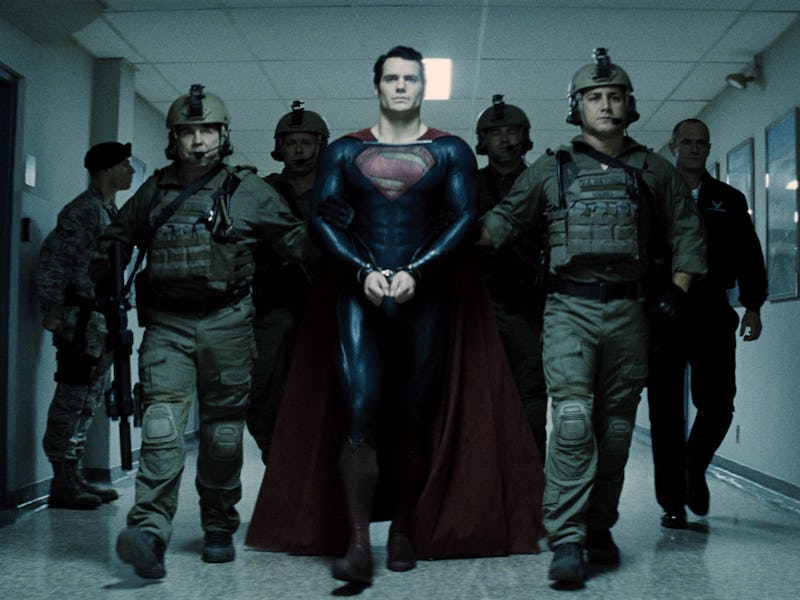How Superman Accidentally Became the Most Influential Superhero of the Century
Zack Snyder’s take on the comic book character is unforgettable, for better or worse.

General Zod wants to reshape Earth in the image of his home planet.
At the height of their power, Kryptonians were aggressive expanders, aliens who colonized worlds lightyears from their own. Zod is one of the last Kryptonians standing. The survival of his race is his core function. So when he discovers a suitable M-class planet that can serve as a new Krypton, he wastes no time attempting to terraform it. That another world already exists on this planet, complete with intelligent life and a thriving society, is of little consequence to Zod. He will rebuild Krypton on the foundation of Earth’s ruin — that is, unless Superman has anything to say about it.
Zack Snyder’s 2013 film Man of Steel reintroduces Superman (Henry Cavill) as a young outcast, one only just beginning to form an understanding of his powers and build the foundations of his iconic morality. His showdown with Zod — set largely in the city of Metropolis — is one of epic, apocalyptic proportions. Entire swaths of the city are leveled by Zod’s terraforming device, the World Engine. It’s 9/11 ratcheted up to mind-numbing proportions, but Snyder’s Superman is surprisingly unconcerned with saving the little guy. Stopping Zod takes up 100 percent of his efforts, which means that the people of Metropolis are forced to fend for themselves, save each other, and find shelter as the Kryptonians brawl in their midst. For better or worse, this tells us a lot about this version of the character, but it also had other unexpected consequences.
Superman is notorious for his staunch morality. Countless comic book storylines have been dedicated to his reverence for life and his reluctance to do harm. He’s by far the most altruistic superhero, possibly ever — but he’s not exactly relatable. In the right hands, that’s hardly a bad thing: the world is already such a bleak and hopeless place, and Superman has always been the answer to that. He’s a hopeful palette cleanser that stands apart and sets an example. When DC set out to reboot the character for the big screen, however, Hollywood was not interested in hope. Angst was the new name of the game, tortured anti-heroes were the new protagonists, and annihilation was just a part of the spectacle.
As a result, Man of Steel introduces us to a very different take on the character. Snyder, screenwriter David Goyer, and producer Christopher Nolan work hard to bend Superman into the archetype that previous franchises (think James Bond or Nolan’s Dark Knight trilogy) used for their own gritty reboots. This Superman is jaded from years of life on the margins. He’s been made to believe that the world will never embrace Kal-El, the Kryptonian refugee that’s spent all his life on Earth — and so he molds himself into Clark Kent.
By the time Zod and his zealots land on Earth, our protagonist is only just beginning to learn what he’s fighting for. Reconnecting with the consciousness of his father, Jor-El (Russel Crowe), helps him to understand his role as a symbol of hope. Man of Steel got a lot of flack for its cataclysmic final act — after all, Superman should know better than to engage with hostiles with civilians still fleeing for cover around them.
Man of Steel’s depiction of carnage — and most notably, the backlash to the collateral damage — ended up being the most influential on later superhero films. Nowadays, blockbusters like to play it safe and set their big battles in fields, airport hangars, or the vacuum of space — in what appears to be a direct reaction to the 2013 film.
Man of Steel introduced a jaded Superman caught between two worlds — a controversial choice, but effective all the same.
Perhaps more than any superhero film that came before, Man of Steel is the epitome of the post-9/11 blockbuster. The film wasn’t just a reboot for its title character, it was effectively a curtain-raiser for a new era of DC films. It lifts heavily from Marvel’s interconnected stories, as well as Nolan’s dour, self-effacing tone from The Dark Knight — but it ultimately creates its own aesthetic, and charts a new path that many of its successors would have to engage with one way or another.
It may seem like overkill to most, but the destruction of that final fight served a purpose: not just to make the stakes feel real, but to establish Superman’s love for humanity in a modern, tactile way. Snyder and Co. caused a lot of controversy in their efforts to humanize Superman. Despite the flaws in Man of Steel — and there are quite a few — the final fight shouldn’t be one of them.